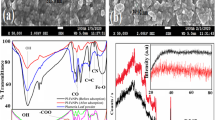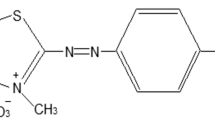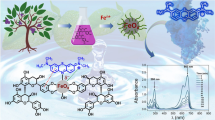Abstract
The most promising eco-friendly green synthesized iron nanoparticles (FeNPs) using jujube leaf extract to decolorize methylene blue (MB) dye was established. Synthesized nanoparticles were characterized through different techniques like TEM, SEM, and FTIR. Various parameters such as dye concentration (5 to 20 mg L−1), nanoparticles load (0.5 to 2.5 mg), temperature, pH, and contact time (30 to 150 min) were optimized. A maximum MB dye removal efficiency of 93.5% is achieved at a time interval of 150 min, temperature 30 °C and pH 9 with 2.5 mg FeNPs for a concentration of 20-mgL−1 methylene blue. The adsorption behavior was monitored using a wide range of isotherm models which includes Freundlich, Dubinin–Radushkevich, Langmuir, and Temkin. The Elovich and intraparticle diffusion models, as well as the dynamical models of pseudo-first- and pseudo-second order has been analyzed for the data obtained from dynamic adsorption. Experimental results were consistent along the paradigm of pseudo-second order. Langmuir adsorption isotherm well suited for adsorption data across exclusive concentration range in comparison to other models. The green synthesized FeNPs has high sorption capacity (1000 mg/g) and environmentally friendly in nature, makes it a potential candidate for wastewater treatment applications.
Graphical Abstract
















Similar content being viewed by others
Data availability
The dataset generated and/or analyzed during the current study are available from the corresponding author [M. Rengasamy], upon reasonable request.
References
Oraon A, Prajapati AK, Ram M, Saxena VK, Dutta S (2022) Gupta AK (2022) Synthesis, characterization, and application of microporous biochar prepared from Pterospermumacerifolium plant fruit shell waste for methylene blue dye adsorption: the role of surface modification by SDS surfactant. Biomass Conv Bioref. https://doi.org/10.1007/s13399-022-02320-8
Afsheen S, Tahir MB, Iqbal T, Liaqat A, Abrar M (2018) Green synthesis and characterization of novel iron particles by using different extracts. J Alloys Compd 732:935–944
Supee AH, Zaini MAA (2022) Phosphoric acid-activated bamboo hydrochar for methylene blue adsorption: isotherm and kinetic studies. Biomass Conv Bioref. https://doi.org/10.1007/s13399-022-03465-2
El-Shamy AG (2020) An efcient removal of methylene blue dye by adsorption onto carbon dot @ zinc peroxide embedded poly vinyl alcohol (PVA/CZnO2) nano-composite: a novel reusable adsorbent. Polymer (Guildf) 202:122565. 10. 1016/j.polymer.2020.122565
Bharathi D, Nandagopal JGT, Ranjithkumar R, Gupta PK, Djearamane S (2022) Microbial approaches for sustainable remediation of dye-contaminated wastewater: a review. Arch Microbiol 204(3):1–11. https://doi.org/10.1007/s00203-022-02767-3
Arularasu MV, Anbarasu M, Poovaragan S, Sundaram R, Kanimozhi K, Magdalane CM, Kaviyarasu K, Thema FT, Letsholathebe D, Mola GT, Maaza M (2018) Structural, optical, morphological and microbial studies on SnO2 nanoparticles prepared by co-precipitation method. J Nanosci Nanotechnol 18:3511–3517. https://doi.org/10.1166/jnn.2018.1465
Holliday MC, Parsons DR (2022) Zein SH (2022) Agricultural pea waste as a low-cost pollutant biosorbent for methylene blue removal: adsorption kinetics, isotherm and thermodynamic studies. Biomass Conv Bioref. https://doi.org/10.1007/s13399-022-02865-8
Saha N, Das L, Das P, Bhowal A, Bhattacharjee C (2021) Comparative experimental and mathematical analysis on removal of dye using raw rice husk, rice husk charcoal and activated rice husk charcoal: batch, fxed-bed column, and mathematical modeling. Biomass Convers Biorefnery. https://doi.org/10.1007/s13399-021-01996-8
Tharani K, Jegatha Christy A, Sagadevan S, Nehru LC (2021) Photocatalytic and antibacterial performance of iron oxide nanoparticles formed by the combustion method. Chem Phys Lett 771:138524. https://doi.org/10.1016/j.cplett.2021.138524
Paluri P, Ahmad KA, Durbha KS (2022) Importance of estimation of optimum isotherm model parameters for adsorption of methylene blue onto biomass derived activated carbons: comparison between linear and non-linear methods. Biomass Conv Bioref 12:4031–4048. https://doi.org/10.1007/s13399-020-00867-y
Goswami M, Baruah D, Das AM (2018) Green synthesis of silver nanoparticles supported on cellulose and their catalytic application in the scavenging of organic dyes. New J Chem 42(13):10868–10878
Raj S, Chand Mali S, Trivedi R (2018) Green synthesis and characterization of silver nanoparticles using Enicostemmaaxillare (Lam.) leaf extract. Biochem Biophys Res Commun 503:2814–2819. https://doi.org/10.1016/j.bbrc.2018.08.045
Razali NS, Abdulhameed AS, Jawad AH, ALOthman ZA, Yousef TA, Al-Duaij OK, Alsaiari NS, (2022) High-surface-area-activated carbon derived from mango peels and seeds wastes via microwave-induced ZnCl2 activation for adsorption of methylene blue dye molecules: statistical optimization and mechanism. Molecules 27:6947. https://doi.org/10.3390/molecules27206947
Suppiah DD, MuhdJulkapli N, Sagadevan S, Johan MR (2023) Eco-friendly green synthesis approach and evaluation of environmental and biological applications of iron oxide nanoparticles. Inorg Chem Commun 152:110700. https://doi.org/10.1016/j.inoche.2023.110700
Selvam K, Sudhakar C, Govarthanan M, Thiyagarajan P, Sengottaiyan A, Balakrishnan S (2017) Eco-friendly biosynthesis and characterization of silver nanoparticles using Tinosporacordifolia (Thunb.) Miers and evaluate its antibacterial, antioxidant potential. J Radiat Res Appl Sci 10:6–12. https://doi.org/10.1016/j.jrras.2016.02.005
Belcaid A, Beakou BH, Bouhsina S, Anouar A (2022) Insight into adsorptive removal of methylene blue, malachite green, and rhodamine B dyes by cassava peel biochar (Manihot esculenta Crantz) in single, binary, and ternary systems: competitive adsorption study and theoretical calculations. Biomass Conv Bioref. https://doi.org/10.1007/s13399-022-02928-w
Abdulhameed AS, Jawad AH, Kashi E, Radzun KA, Zeid A, ALOthman, Lee D. Wilson, (2022) Insight into adsorption mechanism, modeling, and desirability function of crystal violet and methylene blue dyes by microalgae: Box-Behnken design application. Algal Res 67:102864. https://doi.org/10.1016/j.algal.2022.102864
Fadillah G, Yudha SP, Sagadevan S, Fatimah Is, Muraza O (2020) Magnetic iron oxide/clay nanocomposites for adsorption and catalytic oxidation in water treatment applications. Open Chemistry. 18(1):1148–1166. https://doi.org/10.1515/chem-2020-0159
Fatimah Is, Purwiandono G, Hidayat A, Sagadevan S, Kamari A (2022) Mechanistic insight into the adsorption and photocatalytic activity of a magnetically separable γ-Fe2O3/Montmorillonite nanocomposite for rhodamineB removal. Chem Phys Lett 792:139410. https://doi.org/10.1016/j.cplett.2022.139410
Tobaldi DM, Seabra MP, Novais RM, Ascens G (2018) Biomass fly ash geopolymer monoliths for effective methylene blue removal from wastewaters. J Clean Prod 171:783–794
Foo KY, Hameed BH (2010) Insights into the modeling of adsorption isotherm systems. Rev Chem Eng 156:2–10
Golmohammadi M, Honarmand M, Esmaeili A (2022) Biosynthesis of ZnO nanoparticles supported on bentonite and the evaluation of its photocatalytic activity. Mater Res Bull 149:111714. https://doi.org/10.1016/j.materresbull.2021.111714
Alharthi MN, Ismail I, Bellucci S, Jaremko M, Salah EM, Abo-Aba MA, Salam, (2023) Biosynthesized zinc oxide nanoparticles using Ziziphus jujube plant extract assisted by ultrasonic irradiation and their biological applications. Separations 10(2):78. https://doi.org/10.3390/separations10020078
Alharthi MN, Ismail I, Bellucci S, Salam MA (2021) Green synthesis of zinc oxide nanoparticles by Ziziphus jujuba leaves extract: environmental application, kinetic and thermodynamic studies. J Phys Chem Solids 158:110237. https://doi.org/10.1016/j.jpcs.2021.110237
Aisida SO, Madubuonu N, Alnasir MH, Ahmad I, Botha S, Mazza M, Ezema FI (2020) Biogenic synthesis of iron oxide nanorods using Moringa oleifera leaf extract for antibacterial applications. Appl Nanosci 10:305–315. https://doi.org/10.1007/s13204-019-01099-x
Hanafi NAM, Abdulhameed AS (2022) Jawad AH (2022) Optimized removal process and tailored adsorption mechanism of crystal violet and methylene blue dyes by activated carbon derived from mixed orange peel and watermelon rind using microwave-induced ZnCl2 activation. Biomass Conv Bioref. https://doi.org/10.1007/s13399-022-03646-z
Sagadevan S, Sivasankaran RP, Lett JA, Fatimah I, Weldegebrieal GK, Léonard E, Le M-V, Soga T (2023) Evaluation of photocatalytic activity and electrochemical properties of hematite nanoparticles. Symmetry 15:1139. https://doi.org/10.3390/sym15061139
Uddin MK, Malek NNA, Jawad AH, Sabar S (2023) Pyrolysis of rubber seed pericarp biomass treated with sulfuric acid for the adsorption of crystal violet and methylene green dyes: an optimized process. Int J Phytoremediation 25(4):393–402. https://doi.org/10.1080/15226514.2022.2086214
Wang B, Jia M, Fang L, Jiang L, Li Y (2018) Effects of eucalyptus oil and anise oil supplementation on rumen fermentation characteristics, methane emission, and digestibility in sheep. J Anim Sci 96(8):3460–3470. https://doi.org/10.1093/jas/sky216
De Araujo TP, Tavares FO, Vareschini DT, Barros M (2020) Biosorption mechanisms of cationic and anionic dyes in a low-cost residue from brewer’s spent grain. Environ technol. 42(19):1–16. https://doi.org/10.1080/09593330.2020.1718217
Bo L, Gao F, Shuangbao BY, Liu Z, Dai Y (2021) A novel adsorbent Auricularia Auricular for the removal of methylene blue from aqueous solution: isotherm and kinetics studies. Environ Technol&Innov 23:101576. https://doi.org/10.1016/j.eti.2021.101576
Georgin J, Franco DSP, Netto MS, Allasia D, Oliveira MLS, Dotto GL (2020) Treatment of water containing methylene by biosorption using Brazilian berry seeds (Eugenia uniflora). Environ Sci Pollut Res. 27(17):20831–20843. https://doi.org/10.1007/s11356-020-08496-8
Cusioli LF, Quesada HB, Baptista ATA, Gomes RG, Bergamasco R (2020) Soybean hulls as a low-cost biosorbent for removal of methylene blue contaminant. Environ Prog Sustain Energy 39(2):13328. https://doi.org/10.1002/ep.13328
Al-Mahmoud S (2020) Kinetic and thermodynamic studies for the efficient removal of methylene blue using HordeumMurinum as a new biosorbent. Egypt J Chem 63(9):3381–3390. https://doi.org/10.21608/ejchem.2020.16008.1970
Sulyman M, Namiesnik J, Gierak A (2017) Low-cost adsorbents derived from agricultural by-products/wastes for enhancing contaminant uptakes from wastewater: a review. Pol J Environ Stud 26(2):479–510
Tempkin MI, Pyzhev V (1940) Kinetics of ammonia synthesis on promoted iron catalyst. Acta Phys Chim USSR 12:327–356
Machado S, Pacheco JG, Nouws HP, Albergaria JT, Delerue-Matos C (2015) Characterization of green zero-valent iron nanoparticles produced with tree leaf extracts. Sci Total Environ 533:76e81
Machado S, Pacheco JG, Nouws HPA, Albergaria JT, Delerue-Matos C (2015) Characterization of green zero-valent iron nanoparticles produced with tree leaf extracts. Sci Total Environ 533:76–81. https://doi.org/10.1016/j.scitotenv.2015.06.091
Mahmoud AA, El-Feky GS, Kamel R, Awad GEA (2011) Chitosan/ sulfobutylether-β-cyclodextrin nanoparticles as a potential approach for ocular drug delivery. Int J Pharm 413:229–236. https://doi.org/10.1016/j.ijpharm.2011.04.031
Mohan Kumar K, Mandal BK, Siva Kumar K, Sreedhara Reddy P, Sreedhar B (2013) Biobased green method to synthesise palladium and iron nanoparticles using Terminalia chebula aqueous extract. Spectrochim Acta - Part A Mol BiomolSpectrosc 102:128–133. https://doi.org/10.1016/j.saa.2012.10.015
Nassar MY, Abdelrahman EA (2017) Hydrothermal tuning of the morphology and crystallite size of zeolite nanostructures for simultaneous adsorption and photocatalytic degradation of methylene blue dye. J Mol Liq 242:364–374
Langmuir I (1916) The constitution and fundamental properties of solids and liquids. J Am Chem Soc 38(11):2221
Hashem AH, Saied E, Hasanin MS (2020) Green and ecofriendly bio-removal of methylene blue dye from aqueous solution using biologically activated banana peel waste. Sustain Chem Pharm 18:100333. https://doi.org/10.1016/j.scp.2020.100333
Mythili R, Selvankumar T, Kamala-Kannan S, Sudhakar C, Ameen F, Al-Sabri A, Selvam K, Govarthanan M, Kim H (2018) Utilization of market vegetable waste for silver nanoparticle synthesis and its antibacterial activity. Mater Lett 225:101–104. https://doi.org/10.1016/j.matlet.2018.04.111
Aljeboree AM, Al-Baitai AY, Abdalhadi SM, Alkaim AF (2021) Investigation study of removing methyl violet dye from aqueous solutions using corn-cob as a source of activated carbon. Egypt J Chem 64(6):2873–2878. https://doi.org/10.21608/ejchem.2021.55274.3159
Praveen A, Lakshmi Narayana Rao G, Balakrishna B (2018) Performance and emission characteristics of a diesel engine using CalophyllumInophyllum biodiesel blends with TiO2nanoadditives and EGR. Egypt J Pet 27(4):731–738. https://doi.org/10.1016/j.ejpe.2017.10.008
Maleki A, Mohammad M, Emdadi Z, Asim N, Azizi M, Safaei J (2018) Adsorbent materials based on a geopolymer paste for dye removal from aqueous solutions. Arab J Chem 13(1):3017–3025
Abdelrahman EA (2018) Synthesis of zeolite nanostructures from waste aluminum cans for efficient removal of malachite green dye from aqueous media. J Mol Liq 253:72–82
Dastoorian F, Salem A, Salem S (2018) Fabrication of poorly crystalline hydroxyapatite nano-particles by rapid auto-ignition route as efficient adsorbent for removal of disperse blue dye. J Alloys Compd 766:729–738
Freundlich HMF (1906) Over the adsorption in solution. J Phys Chem 57:385–471
Hevira L, Zilfa R, Ighalo JO, Aziz H, Zein R (2021) Terminalia catappa shell as low-cost biosorbent for the removal of methylene blue from aqueous solutions. J Ind Eng Chem 97:188–199. https://doi.org/10.1016/j.jiec.2021.01.028
Siqueira TCA, de Silva IZ, Rubio AJ, Bergamasco R, Gasparotto F, Paccola EAS, Yamaguchi NU (2020) Sugarcane bagasse as an efficient biosorbent for methylene blue removal: kinetics, isotherms and thermodynamics. Int J Environ Res Public Health 17:526. https://doi.org/10.3390/ijerph17020526
Liu X-J, Li M-F, Singh SK (2021) Manganese-modified lignin biochar as adsorbent for removal of methylene blue. J Market Res 12:1434–1445
Yu KL, Lee XJ, Ong HC, Chen W-H, Chang J-S, Lin C-S, Show PL, Ling TC (2021) Adsorptive removal of cationic methylene blue and anionic Congo red dyes using wet-torrefied microalgal biochar: Equilibrium, kinetic and mechanism modeling. Environ Pollut 272:115986
Zhang P, O’Connor D, Wang Y, Jiang L, **a T, Wang L, Tsang DC, Ok YS, Hou D (2020) A green biochar/iron oxide composite for methylene blue removal. J Hazard Mater 384:121286
Qian W-C, Luo X-P, Wang X, Guo M, Li B (2018) Removal of methylene blue from aqueous solution by modified bamboo hydrochar. Ecotoxicol Environ Saf 157:300–306
Eltaweil AS, Abd El-Monaem EM, El-Subruiti GM, Abd El-Latif MM, Omer AM (2020) Fabrication of UiO-66/MIL-101 (Fe) binary MOF/carboxylated-GO composite for adsorptive removal of methylene blue dye from aqueous solutions. RSC Adv 10(32):19008–19019
Dubinin MM (1960) The potential theory of adsorption of gases and vapors for adsorbents with energetically nonuniform surfaces. Chem Rev 60(2):235–241
Agarwal S, Tyagi I, Gupta VK, Ghasemi N, Shahivand M, Ghasemi M (2016) Kinetics, equilibrium studies and thermodynamics of methylene blue adsorption on Ephedra strobilacea saw dust and modified using phosphoric acid and zinc chloride. J Mol Liq 218:208–218
Li B, Gan L, Owens G, Chen Z (2018) New nano-biomaterials for the removal of malachite green from aqueous solution via a response surface methodology. Water Res 146:55–66
Sharma A, Siddiqui ZM, Dhar S, Mehta P (2019) Adsorptive removal of congo red dye (CR) from aqueous solution by Cornulacamonacantha stem and biomass-based activated carbon: isotherm, kinetics and thermodynamics. Sep Sci Technol 54:916–929
Ho YS, McKay G (1999) Pseudo-second order model for sorption processes. Process Biochem 34:451–465
Ho YS (2004) Citation review of Lagergren kinetic rate equation on adsorption reactions. Scientometrics 59:171–177. https://doi.org/10.1023/B:SCIE.0000013305.99473.cf
Sengottaiyan A, Aravinthan A, Sudhakar C, Selvam K, Srinivasan P, Govarthanan M, Manoharan K, Selvankumar T (2016) Synthesis and characterization of Solanum nigrum-mediated silver nanoparticles and its protective efect on alloxan-induced diabetic rats. J Nanostructure Chem 6:41–48. https://doi.org/10.1007/s40097-015-0178-6
Gupta T, Lataye D (2019) Removal of crystal violet and methylene blue dyes using Acacia nilotica sawdust activated carbon. Indian J Chem Technol 26:52–68
Mane VS, Mall ID, Srivastava VC (2007) Kinetic and equilibrium isotherm studies for the adsorptive removal of Brilliant Green dye from aqueous solution by rice husk ash. J Environ Manage 84:390–400
Wang T, ** X, Chen Z et al (2014) Green synthesis of Fe nanoparticles using eucalyptus leaf extracts for treatment of eutrophic wastewater. Sci Total Environ 466–467:210–213. https://doi.org/10.1016/j.scitotenv.2013.07.022
Wang T, Lin J, Chen Z, Megharaj M, Naidu R (2014) Green synthesized iron nanoparticles by green tea and eucalyptus leaves extracts used for removal of nitrate in aqueous solution. J Clean Prod 83:413e419
Wang W-L, Cai Y-Z, Hu H-Y, Chen J, Wang J, Xue G, Wu Q-Y (2019) Advanced treatment of bio-treated dyeing and finishing wastewater using ozonebiological activated carbon: a study on the synergistic effects. Chem. Eng J 359:168e175
Weber WJ, Morris JC (1963) Kinetics of adsorption on carbon from solutions. J Sanit Eng Div 89:31–39
Weng X, Huang L, Chen Z, Megharaj M, Naidu R (2013) Synthesis of iron-based nanoparticles by green tea extract and their degradation of malachite. Ind Crop Prod 51:342e347
**ao Z, Zhang H, Xu Y, Yuan M, **g X, Huang J, Li Q, Sun D (2017) Ultraefficient removal of chromium from aqueous medium by biogenic iron based nanoparticles. Separ Purif Technol 174:466e473
Martinez CLM, Sermyagina E, JussiSaari MS, de Jesus M, Cardoso GM, de Almeida EsaVakkilainen (2021) Hydrothermal carbonization of lignocellulosic agro-forest based biomass residues. Biomass Bioenergy 147:106004. https://doi.org/10.1016/j.biombioe.2021.106004
Zhang L, Sellaoui L, Franco D, Dotto GL, Bajahzar A, Belmabrouk H, Bonilla Petriciolet A, Oliveira MLS, Li Z (2020) Adsorption of dyes brilliant blue, sunset yellow and tartrazine from aqueous solution on chitosan: analytical interpretation via multilayer statistical physics model. Chem Eng J 382:122952
Acknowledgements
The authors are thankful to the Bharathidasan Institute of Technology (BIT) Campus, Anna University, Trichirapalli-620 024 and Annamalai University, Annamalai nagar, Chidambram, India, for the technical support.
Author information
Authors and Affiliations
Contributions
All authors contributed to the study conception and design. All authors edited and approved the final version of the manuscript.
Corresponding author
Ethics declarations
Ethical approval and consent to participate
Not applicable.
Consent of publication
Not applicable.
Competing interest
The authors declare no competing interests.
Additional information
Publisher's Note
Springer Nature remains neutral with regard to jurisdictional claims in published maps and institutional affiliations.
Rights and permissions
Springer Nature or its licensor (e.g. a society or other partner) holds exclusive rights to this article under a publishing agreement with the author(s) or other rightsholder(s); author self-archiving of the accepted manuscript version of this article is solely governed by the terms of such publishing agreement and applicable law.
About this article
Cite this article
Venkatesan, G., Koteshwaran, S., Rengasamy, M. et al. Efficient removal of methylene blue dye by iron nanoparticles synthesized by a novel green method using jujube leaf extract: characterization, kinetics, and isotherm studies. Biomass Conv. Bioref. (2023). https://doi.org/10.1007/s13399-023-05071-2
Received:
Revised:
Accepted:
Published:
DOI: https://doi.org/10.1007/s13399-023-05071-2




